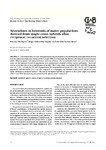Por favor, use este identificador para citar o enlazar este ítem:
http://www.alice.cnptia.embrapa.br/alice/handle/doc/487790| Título: | Alterations in heterosis of maize populations derived from single-cross hybrids after reciprocal recurrent selection. |
| Autor: | RAPOSO, F. V.  RAMALHO, M. A. P.   RIBEIRO, P. H. E.   |
| Afiliación: | Embrapa Milho e Sorgo. |
| Año: | 2004 |
| Referencia: | Crop Breeding and Applied Biotechnology, Londrina, v. 4, n. 1, p. 74-80, Mar. 2004. |
| Descripción: | One hundred and sixty-nine interpopulational half sib progenies were obtained from maize populations derived from the commercial single-cross hybrids AG9012 (1) and C333 (2) to investigate the efficiency of reciprocal recurrent selection (RRS). Fifteen progenies with highest hulled ear yield were obtained. Two recombination trials were sown with remnant S1 seeds, and the improved CI1 and CI2 populations were simultaneously obtained with their hybrid combination. Yield trials were set up in three sites to assess the efficiency of the RRS. The F1 from single-cross hybrid AG9012 and C333, the double-cross (F1(1)x F1(2) hybrids, the C0 1 and C02 populations, the interpopulational hybrid (C01 x C02), the CI1 and CI2 improved populations, and their hybrid (CI1 x CI2) were compared. A 5.7% progress was obtained in one cycle of RRS for ear yield, mainly attributed to increased heterosis. The yield of the improved hybrid was superior to the F1 from single-cross hybrids AG9012 and C333, demonstrating the potential of the referred hybrid combination. Para verificar a eficiência da seleção recorrente recíproca (SRR) em populações originárias dos híbridos simples comerciais AG9012 (1) e C333 (2) foram obtidas, inicialmente, 169 progênies de meios-irmãos interpopulacionais. As 15 melhores progênies em produção de espigas despalhadas foram identificadas. Utilizando-se sementes S1 remanescentes, semearam-se dois campos de recombinação, sendo simultaneamente obtidas as populações melhoradas C1 1 e C1 2 e a combinação híbrida entre elas. Os experimentos para avaliar a eficiência da SRR foram instalados em três locais. Foram comparados o F1 dos híbridos simples AG9012 e C333, o híbrido duplo F1(1) x F1 (2), entre eles as populações CD1 e CD2, o híbrido interpopulacinal (CD1 e CD2), as populações melhoradas C1 1 e C1 2 e a sua combinação híbrida (C1 1 e C 1 2). O progresso com um ciclo de SRR foi de 5,7% para a produção de espigas e deveu-se , principalmente, ao incremento na heterose. O desempenho do híbrido melhorado superou a geração F1 dos híbridos simples AG9012 e C333, evidenciando o potencial da referida combinação híbrida. |
| Thesagro: | Milho |
| Palabras clave: | Genética quantitativa Seleção recorrente recíproca Heterose |
| Tipo de Material: | Artigo de periódico |
| Acceso: | openAccess |
| Aparece en las colecciones: | Artigo em periódico indexado (CNPMS)  |
Ficheros en este ítem:
| Fichero | Descripción | Tamaño | Formato | |
|---|---|---|---|---|
| Alterationsheterosis.pdf | 358,25 kB | Adobe PDF |  Visualizar/Abrir |









